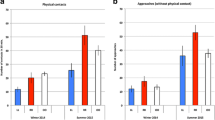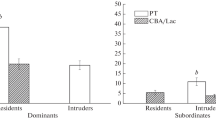Abstract
The social interactions between Apodemus agrarius and A. flavicollis, and their behavioral responses to conspecific and heterospecific odors, were studied in male–male and female–female interspecific dyadic encounters, and an attraction–avoidance test was used in order to clarify the behavioral mechanisms which control their relationships in wild populations. The experiments were carried out at the beginning and at the end of the breeding season—in spring and in autumn. In spring the aggressiveness was higher than in autumn. Males of both species showed attraction to conspecific odors from the opposite sex, while the females were indifferent. In autumn both males and females displayed attraction to conspecific odors from the same sex. However, mice of both species showed avoidance to heterospecific odors from the same and the opposite sex in spring, and indifference to heterospecific odors from the same and the opposite sex in autumn. Based on these findings, it could be assumed that the patterns of social interactions and responses to conspecific and heterospecific odors undergo seasonal changes in their life cycle. Probably the avoidance response to heterospecific odors could serve as a spacing mechanism to avoid aggressive encounters between A. agrarius and A. flavicollis in syntopic habitats during the breeding period.

Similar content being viewed by others
References
Andrzejewski R, Babinska-Werka J, Gliwicz J, Goszczynski J (1978) Synurbization processes in population of Apodemus agrarius. I Characteristics of populations in an urbanization gradient. Acta Theriol 23:341–358
Agrell J (1997) Experimental testing of female mating strategies in microtine rodents. In: Abstracts of the Seventh International Theriological Congress, Acapulco, Mexico, p 5
Baker RJ, Makova KD, Chesser RK (1999) Microsatellites indicate a high frequency of multiple paternity in Apodemus (Rodentia). Mol Ecol 8:107–111
Barnard CJ, Fitzsimons J (1988) Kin recognition and mate choice in mice: the effect of kinship, familiarity and social interference on intersexual interaction. Anim Behav 36:1078–1090
Bartmann S, Gerlach G (2001) Multiple paternity and similar variance in reproductive success of male and female wood mice (Apodemus sylvaticus) housed in an enclosure. Ethology 107:889–899
Bimova B, Karn R, Pialek J (2005) The role of ABP in reproductive isolation between two subspecies of house mouse: Mus musculus musculus and Mus musculus domesticus. Biol J Linnean Soc 84:349–361
Brown LE (1966) Home range and movement of small mammals. Symp Zool Soc Lond 18:111–142
Brown LE (1969) Field experiments on the movements of Apodemus sylvaticus L. using trapping and tracking techniques. Oecologia 2:198–222
Brown RE (1979) Mammalian social odors: a critical review. Advan Study Behav 10:103–162
Čiháková J, Frynta D (1996) Intraspecific and interspecific behaviour interactions in the wood mouse (Apodemus sylvaticus) and the yellow-necked mouse (Apodemus flavicollis) in a neutral cage. Folia Zool 45:105–113
Cockel J, Ruf T (2001) Alternative seasonal strategies in wild rodent populations. J Mammal 82:1034–1046
Cox TR (1984) Ethological isolation between local populations of house mice (Mus musculus) based on olfaction. Anim Behav 32:1068–1077
Cox TR (1989) Odor-based discrimination between non-continuous demes of wild Mus. J Mammal 70:549–556
Christophe N, Baudoin C (1998) Olfactory preferences in two strains of wild mice, Mus musculus musculus and Mus musculus domesticus, and their hybrid. Anim Behav 56:365–369
Daly M, Wilson MI, Faux SF (1978) Seasonally variable effect of conspecific odors upon capture of deer mice Peromyscus maniculatus gambelli. Behav Biol 23:254–259
Dickman CR, Doncaster CP (1986) The ecology of small mammals in urban habitats. I Populations in patchy environmental. J Anim Ecol 56:629–640
Dixon AK, Fisch HU (1989) The ethopharmacological study of drug induced changes in behaviour. In: Blanchard RJ, Brain PF, Blanchard DC, Parmigiani S (eds) Ethoexperimental approaches to the study of behaviour. Kluwer, Dordrecht, pp 451–473
Doty RL (1972) Odor preferences of female Peromyscus maniculatus bairdi for male mouse odours of P. m. bairdi and P. Leucopus noveboracensis as a function of estrous state. J Compar Physiol Psychol 81:191–197
Doty RL (1973) Reactions of deer mice (Peromyscus maniculatus) and white-footed mice (Peromyscus leucopus) to homospecific and heterospecific urine odours. J Comp Physiol Psychol 84:296–303
Egid K, Brown JL (1989) The major histocompatibility complex and female mating preferences in mice. Anim Behav 38:548–550
Ferkin MH, Seamon JO (1987) Odor preference and social behavior in meadow voles, Microtus pennsylvanicus: seasonal differences. Can J Zool 65:2931–2937
Ferkin MH, Sorokin ES, Johnston RE (1995) Seasonal changes in scents and responses to them in meadow voles: evidence for the co-evolution of signals and response mechanisms. Ethology 100:89–98
Fowler J, Cohen L, Jarvis P (1998) Practical statistics for field biology. Wiley, Chichester
Frynta D, Exnerová A, Nováková A (1995) Intraspecific behaviour interactions in the striped field-mouse (Apodemus agrarius) and its interspecific relationships to the wood mouse (Apodemus sylvaticus): dyadic encounters in a neutral cage. Acta Soc Zool Bohem 59:53–62
Gouat P, Patris B, Lalande C (1998) Conspecific and heterospecific behavioural discrimination of individual odours by mound-building mice. C R Acad Sci 321:571–575
Gouat P, Katona K, Poteaux C (2003) Is the socio-spatial distribution of mound-building mice, Mus spicilegus, compatible with a monogamous mating system? Mammalia 67:15–24
Gurnell J (1978) Seasonal changes in numbers and male behavioural interaction in population of wood mice, Apodemus sylvaticus. J Anim Ecol 47:741–755
Halpin ZT (1986) Individual odours among mammals: origins and functions. Adv Stud Behav 16:39–70
Heth G, Todrank J (1995) Assessing chemosensory perception in subterranean mole rats: different responses to smelling versus touching odours stimuli. Anim Beh 49:1009–1015
Heth G, Beauchamp GK, Nevo E, Yamazaki K (1996) Species, population and individual specific odors in urine of mole rats (Spalax ehrenbergi) detected by laboratory rats. Chemoecology 7:107–111
Hoffemeyer I (1973) Interaction and habitat selection in mouse Apodemus flavicollis and Apodemus sylvaticus. Oikos 24:108–116
Huck UW, Banks EM (1982) Differential attraction of females to dominant males: olfactory discrimination and mating preferences in the brown lemming (Lemmus trimucronatus). Behav Ecol Sociobiol 11:217–222
Hurst JL (1989) The complex network of olfactory communication on population of wild house mice Mus domesticus Rutty: urine marking and investigation within family groups. Anim Behav 37:705–725
Hurst JL (1990) Urine marking in population of wild house mice Mus domesticus Rutty. I: communication between males. Anim Behav 40:209–222
Kosoj ME (1984) Formation of winter aggregations in striped field-mouse (Apodemus agrarius) (In Russian). Zool Zh 63:1396–1402
Krackow S, Matuschak B (1991) Mate choice for non-siblings in wild house mice: evidence from a choice test and a reproductive test. Ethology 88:99–108
Laukaitis C, Critser E, Karn R (1997) Salivary androgen-binding protein (ABP) mediates sexual isolation in Mus musculus. Evolution 51:2000–2005
Lehner Ph (1996) Handbook of ethological methods. Cambridge University press, Cambridge
Livoreil B, Gouat P, Baudoin C (1993) A comparative study of social behaviour of two sympatric ground squirrels (Spermophilus spilosoma, S. mexicanus). Ethology 93:236–246
Mackintosh JH (1981) Behaviour of the house mouse. Symp Zool Soc Lond 47:337–365
Maslak S, Gouat P (2002) Short-term contact elicits heterospecific behavioral discrimination of individual odors in mound-building mice (Mus spicilegus). J Comp Psychol 116:357–362
Montgomery WI (1978) Intra and interspecific interaction of Apodemus sylvaticus (L.) and Apodemus flavicollis (Melchoir) under laboratory conditions. Anim Behav 26:1247–1254
Montgomery WI (1980) Spatial organization in sympatric populations of Apodemus sylvaticus and Apodemus flavicollis (Rodentia:Muridae). J Zool Lond 192:379–401
Musolf K (2002) Verhaltensökologische Untersuchung an Waldmäusen (Apodemus sylvaticus)—behavioral ecology studies of wood mice (Apodemus sylvaticus). PhD Thesis, Faculty of Biology, University of Konstanz
Newman KS, Halpin ZT (1988) Individual odours and mate recognition in the prairie vole Microtus ochrogaster. Anim Behav 36:1779–1787
Nevo E, Bodmer M, Heth G (1976) Olfactory discrimination as an isolating mechanism in speciating mole rats. Experientia 32:1511–1512
Popov V, Sedefchev A (2003) The mammals in Bulgaria—handbook (In Bulgarian). Vitosha Library, Geosoft, Sofia, pp 144–145
Patris B, Baudoin C (1998) Female sexual preferences differ in Mus spicilegus and Mus musculus domesticus: the role of familiarization and sexual experience. Anim Behav 56:1465–1470
Patris B, Gouat P, Jacquot C, Christophe N, Baudoin C (2002) Agonistic and sociable behaviours in the mound-building mouse, Mus spicilegus: a comparative study with Mus musculus domesticus. Aggress Behav 28:75–84
Peshev Tz, Nankinov D, Peshev D (2000) The handbook of the Bulgarian vertebrates (In Bulgarian). Bulvest Press, Sofia
Rudran R, Kunz T (1996) Appendix 1. Ethics in research. In: Wilson DE, Cole FR, Nichols JD, Rudran R, Foster MS (eds) Measuring and monitoring biological diversity. Standard methods for mammals. Smithsonian Institution Press, Washington and London, pp 251–254
Rosakis A (1999) Populationsgenetische Untersuchungen an Gelbhalsmäusen (Apodemus flavicollis). Diplomarbeit der Fakultät für Biologie, Universität Konstanz, Germany
Rychlik L (1998) Evolution of social systems in shrews. In: Wójcik JM, Wolsan M (eds) Evolution of shrews. Mammal Research Institute, Polish Academy of Sciences, Białowieża, pp 347–406
Sharpe ST, Millar JS (1991) Influence on the variation in initiation of breeding in Peromyscus maniculatus. Can J Zool 69:698–705
Simeonovska-Nikolova D (2004) Seasonal changes in social behaviour and spatial structure of Crocidura leucodon in north-western Bulgaria. Acta Theriol 49:167–179
Simeonovska-Nikolova D (2006) Social interactions in the striped field-mouse Apodemus agrarius (Mammalia: Rodentia, Muridae). Acta Zool Bulg 58(1) (in print)
Sokolov VE, Kotenkova EV, Ljalukchina SI (1990) Biologija domovoj i kurganchikovoj mysej. (The biology of the House mouse and Mound-building mouse) Nauka, Moscow (in Russian)
Stoddart DM (1986) The comparative responses of mice and moles to conspecific and heterospecific odours in the field—a lesson in social behaviour. In: Duvall D, Muller-Schwartze D, Silverstein RM (eds) Chemical signals in vertebrates IV. Plenum Press, New York, London, pp 533–550
Stopka P, Macdonald DW (1999) The market effect in the wood mouse, Apodemus sylvaticus: selling information on reproductive status. Ethology 105:969–982
Talley H, Laukaitis C, Karn R (2001) Female preference for male saliva: implications for sexual isolation of Mus musculus subspecies. Evolution 55:631–634
White AM, RR Swaisgood, Zhang H (2004) Urinary chemosignals in giant pandas (Ailuropoda melanoleuca): seasonal and developmental effects on signal discrimination. J Zool 262:231–238
Wolton RJ, Flowerdew JR (1985) Spatial distribution and movements of wood mice, yellow-necked mice and bank voles. Symp Zool Soc Lond 55:249–275
Yalden DV (1980) Urban small mammals. J Zool Lond 191:403–406
Zgrabszyńska E, Piłacińska B (2002) Social relations in family group of wood mice Apodemus sylvaticus under laboratory and enclosure conditions. Acta Theriol 47:151–162
Acknowledgements
I wish to thank Maria Miladinova for her help in the laboratory experiments and the two referees for their comments and recommendations for improving the standard of the present manuscript.
Author information
Authors and Affiliations
Corresponding author
About this article
Cite this article
Simeonovska-Nikolova, D.M. Interspecific social interactions and behavioral responses of Apodemus agrarius and Apodemus flavicollis to conspecific and heterospecific odors. J Ethol 25, 41–48 (2007). https://doi.org/10.1007/s10164-006-0203-9
Received:
Accepted:
Published:
Issue Date:
DOI: https://doi.org/10.1007/s10164-006-0203-9




